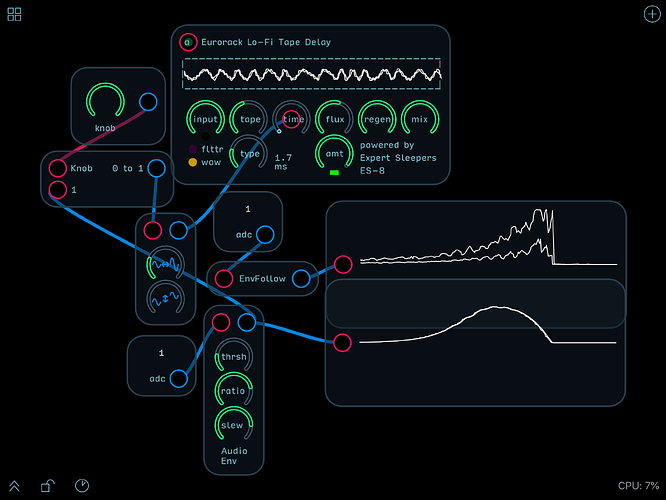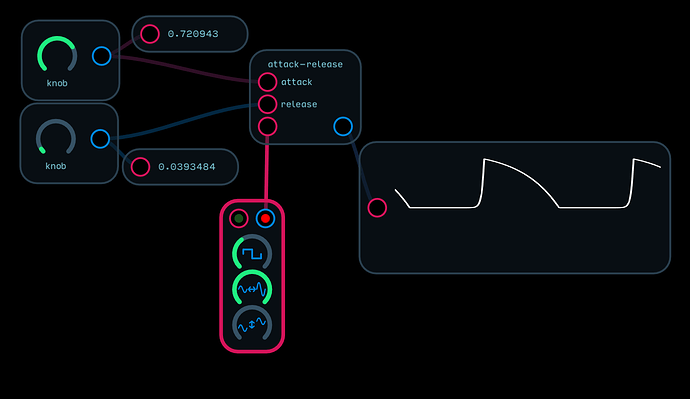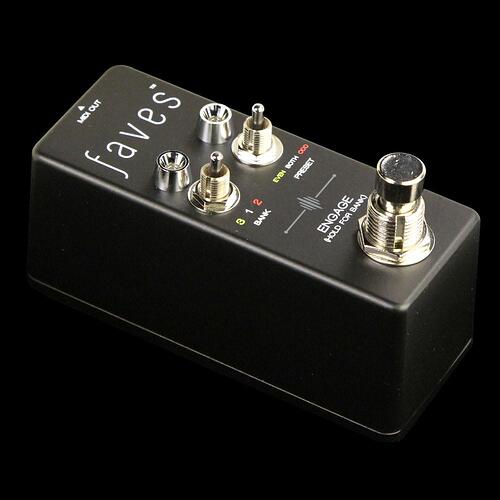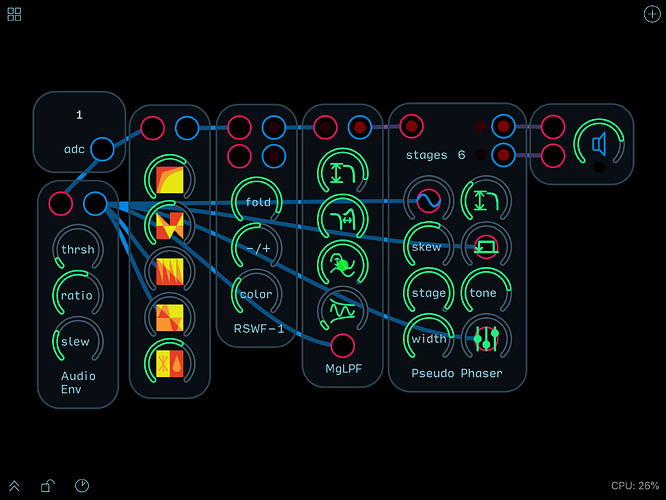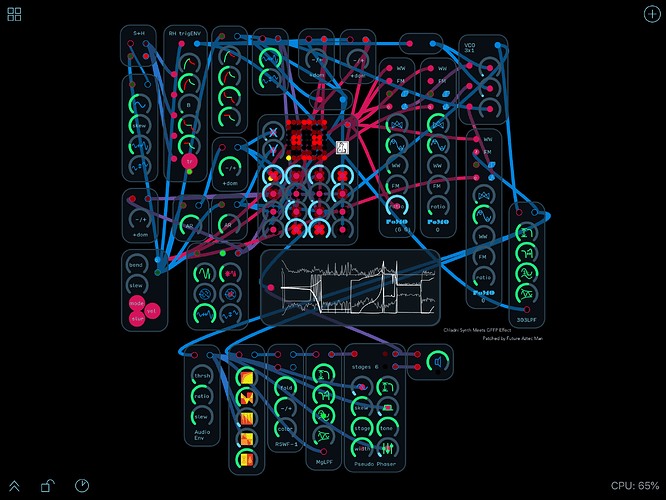Yeah my point though is it’s more about controlling the articulation of the Wah - most of the time you’re just stuck with the envelope it gives you whereas with this you can do more fine tuned tweaking. Try that patch out but switch out the filters to get different sounds 
The compressor that this is from is one of mine. With a compressor the idea is to detect the level of the incoming signal and adjust the gain to compensate. Level detection generally takes one of two approaches. the most common is calculating the RMS (or root mean square) value of the signal. This is a good approximation of the total energy of the signal at a given time. Unfortunately I couldn’t come up with any good way of calculating it in Audulus. The second approach is some type of filtered peak detection. The compressor rectifies the audio input signal, converts it to the dB scale and compares it to the compression curve. It determines the amount the signal exceeds the curve (overshoot). This value is fed to the peak detector which smooths this signal and controls the gain of the compressor. The peak detector is essentially two z-1 based first order exponential moving average low pass filters. Actually if I were to build it now I would probably just use the built in low pass node. xL is the amount of overshoot from the comparator. It’s first fed to the left filter which compares the input to the last filter output times alpha. If the input is higher, then the signal isn’t falling (attack). If the input is lower, the signal is falling (release). Attack signals are passed through and release signals are filtered. The output of this filter is then sent to the attack filter. Since rising signals pass through the release filter unchanged the attack filter is the only filter applied. For falling signals, both filters are applied. This may be an error. If I remember correctly I think I was adapting someone else’s code for Audulus. The second filter should probably only have been applied to rising values, but since the release is generally much longer than the attack it probably doesn’t matter much in practice.
Thanks so much for the background on the STS Compressor. In terms of the video by Chase Bliss, what is your opinion on the “Audio Envelope” that @robertsyrett cooked up? Since you have such a practical angle from building the compressor I would be interested to hear your take. From what you wrote, clearly there are some detailed complexities in the digital “circuit” routing methods for forming and then reintroducing shaped signals into audio chains.
I really haven’t been able to work on anything today. Chase Bliss interests me because they really push what is possible in with pedals that have cv’s and tap tempo sequencing? I am not really in a position to whip out some awesome version of one of these pedals, but I feel like the Audio Envelope could open up some interesting possibilities for combinations of existing modules.
Here is a very quick use case example. I get another layer of warble by modulating this tape delay.
ES-8 Tape Delay Experiments w AudEnv.audulus (118.4 KB)
I haven’t had a chance to watch the Chase Bliss video yet, I was out shopping almost all day. I’ll certainly let you know what I think. I redid the peak detector to properly separate the attack and release filters and thought I’d post it in case you found it useful. The attack and release inputs are in seconds. It is a first order filter, so the curves are exponential. Remember, if you want to use it as a level detector, you need to rectify the audio signal first (use an abs() expression).
Attack-Release V1.0.audulus (14.1 KB)
Interesting pedal. It suffers from the same problem that many sophisticated pedals have. Too many functions/modes for the available controls. During my days as an erstwhile rock guitarist (I know, I know, the grass was greener, we walked uphill both ways, etc.) we had three pedals, Fuzz, Wah-wah, and if you were well off, you might have a tape echo (my echo was neat but VERY noisy). Each pedal had a single function, so they were easy to use on stage. I think today’s pedals suffer from feature bloat. (kinda like iPhones) Honestly I don’t know how you remember what to press, let alone how to use one effectively while also trying to play a set. I have one multifunction digital pedal that does almost everything, but I have to get the manual out every time I want to use it, and don’t even think about re-programming it! (hold button1 , touch button 2, read 2 digit display, twist head to left, etc.) That being said, it seems like a neat pedal. Take a delay chip and modulate the delay in various ways to cause pitch and tempo shifts. You can definitely get some interesting effects by doing this. The same approach works pretty well with the Audulus delay node as well. It would definitely be possible to build this in Audulus. You could certainly use @robertsyrett’s envelope follower as a modulation source for the delay or repeat rate for the delay module, I guess it depends on what you’re trying to achieve. Another circuit I’ve wanted to build for a while, but haven’t experimented with is an impulse detector. Something that would trigger on a rapid attack (like striking a chord or note) but ignore more legato phrases. Coupled with an appropriate ramp, you could make some neat effects that would vary as your playing style changed.
If you want a look at a pretty effective threshold detector have a look at @biminiroad’s audio icebox.
A few things. First and foremost, I am not a guitarist who plays sets. I also don’t really love the sound of the guitar, but I do like getting into tone shaping. Then there is another side. I really like synths and sound design. I also enjoyed building some actual pedals this winter. And I don’t want to drop $300-$500US on one of those Chase Bliss ones. I really like the story of the company though – the aesthetic appreciation, the conscious balance of analog and digital. As I posted elsewhere they have a pedal called Faves, so with these complex ramp knobs you can dial in something interesting and then save the presets in the bank, which is pretty awesome.
So the reason I was interested in what @robertsyrett ended up calling an Audio Triggered Envelope was because I figured I could take a static effect patch from the Audulus back catalog, and give it some sweeping responsiveness to an audio input. Of course I feel like it would be really fun to try and soft-clone some of these pedals but that is way out of my league at this point.
That sounds interesting, an impulse detector…This must be the future we are finally in. ![]()
I was inspired by Pittsburg Modular’s warp circuit. After noticing that high harmonic content seems to make for better reverb effects down the line, I thought I should try running a real stringed instrument through it. That is, @robertsyrett slapped together a folding module for squarewaves. So I thought I should see if strings sound better running through this module. I think so. Here is a patch for stringed instruments. It also incorporates @robertsyrett’s audio envelope. Slapped together in 5 minutes, I will be exploring this more. I think some ground can be made by treating the audio envelope as the master modulator, then breaking out into other envelopes, attenuators, attenuverters, etc…
Mature Reverb.audulus (288.5 KB)
Try plucking a string, mute it with your hand and listen to the tails. Or just play and get a nice dampened wash.
Also, does anyone know how to derive a gate from an envelope, or from the audio signal itself. It would be nice to have a threshold gate. Then as soon as there is a rise in that audio signal, one could get a gate for other purposes. I know you guys have done this somewhere.
Okay. So I tipped over the mountain here today. Personally, I have just unlocked the Chase Bliss world for myself. Mainly this is because of the audio envelope tool, as well as the Delay Looper Sync and the Delay Clock Sync. These have been around for a while, it was just a matter of getting into it. But also, just getting a chance to interact with the pedals in a soundproof room for a while gave me an idea on how to start riffing off of them.
Quite a few of the Chase Bliss pedals are digital delay based. They have loop circuits, and “ramping” lfo’s. Thermae, Mood, and Dark World seemed very similar to me.
So I think what I have here is just the foundation for a lot of interesting experimentation.
Blasé Chintz.audulus (529.1 KB)
If you are into guitar pedals and want to upload some configurations here, please do. I feel like I just walked into a new land.
I am going to fill this post with various humble iterations. This one gets a little more infinite. Obviously, these patches are for running your guitar/bazuki/cello through.
Blasé Chintz 2.audulus (529.1 KB)
Added a tape degrade stage. Has a long loop delay. (Fixed)
Blasé Chintz 3.audulus (564.6 KB)
More immediate. More wild.
Blasé Chintz 4.audulus (580.1 KB)
Yes, the impulse detector.

Here is a ukulele run dry through Audulus in one take, into the patch below and recorded dry in AUM.
https://soundcloud.com/futureaztec/high-noon-3rd-master
High Noon.audulus (653.5 KB)
That’s some crazy sounding uke! ![]()
The track was a bit quiet, so I treated it with the Isotope trial software. Probably compressed it a bit too much. But no guitar pedals were armed during the test, those are just Audulus effects.
Here’s an audio gate I put together this morning. It consists of an envelope follower fed into an attack-release module. the output of the module is compared to a threshold level and the gate goes high if the threshold is exceeded. The attack and release times are adjustable. Although it’s labeled as an audio gate, you can feed audio, an envelope or LFO signal into it, any signal will work. To use it as a noise gate use the gate output to control the signal level. It’s really pretty similar to @robertsyrett’s Audio Envelope, but the variable AR adds some functionality. In @robertsyrett’s design the slew is applied to the output but in this case the AR is applied to the signal before the threshold detector.

Audio Gate V1.0.audulus (24.9 KB)
Wow, that’s super nice! I especially like the attack/decay filter inside. ![]()
![]()
I was wondering, is it possible to make linear slew using z-1 filters? I tried looking it up myself but all the DSP I could find involved convolution of triangles and rectangles and I was left scratching my head about how to implement that in Audulus.
Thanks for the compliment. BTW if you have an earlier version of the uAR I put together, I think the attack and release are swapped. I did a newer version of both a linear and exponential AR here:
Note that currently they both only work for positive signals. I’m working on a design that will work for positive and negative going signals but it requires a somewhat different approach.
